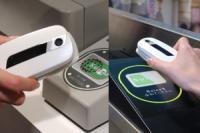Technology Update
Virtual Wallet Services -- the end of Japan's cash era?
by Arjen van Blokland

Despite the efforts of credit card companies, the majority of payments in Japan are still made in cash. Japanese love cash. Major players like Sony, Japan Railways East (JR East), the am/pm convenience store chain, and mobile carriers have launched a huge initiative to push virtual wallets on mobile phones. Can the combination of mobile and smart card technology change the way Japanese make payments?
Sony developed the underlying technology. Called Felica, the technology allows the embedding of an IC chip and internal antenna in a card (the word "Felica" is a combination of "felicity" and "card," suggesting an easier and more convenient life). Contactless communication is activated by weak electronic signals from an external reader-writer device. The handset or smart card receives these signals. Communication is even possible when the handset is switched off.
With a single card, multiple data sets for different purposes can be managed. The operating system embedded in Felica has a file system that securely separates data by application. A company can use Sony's software development kit to create its own Felica applications.
A major platform making use of Felica is Suica, the IC card ticketing system introduced by JR East in 2001. Suica cards can be purchased at stations and re-charged up to a balance of 20,000 yen at vending machines. JR East has equipped all its ticketing gates with reader-writers.
Sony strove to make Felica fast and secure; speed and security are vital requirements of a virtual wallet ("Suica," in fact, is a portmanteau of the mimetic word sui-sui ["quick"] and ca, short for "card"). JR East's busiest stations in Tokyo must be able to handle thousands of secure debit card transactions per minute. When passengers pass through the ticket gate, they hold the Suica card against the Felica reader-writer device. During this touch-and-go, card and reader authenticate each other, followed by a data read-write for the contactless payment. These three steps, including secure encryption, must be completed within one tenth of a second. Dynamic generation of the encryption key with each instance of mutual authentication of reader and card minimizes the risk of fraud.
Suica has met with an enthusiastic reception, with more than 12 million Suica cards issued to date. The card can also be used to pay at station shops and restaurants.
Felica technology is widely used in Japan. Convenience store chain 'am/pm' adopted the 'Edy' electronic money service system in July 2002. The Felica IC chip with antenna is embedded in the Edy debit card. This debit card system is operated by Japanese company BitWallet, whose major shareholders are NTT DoCoMo, Sony, several large banks and Toyota. After purchasing the Edy card, the user can add value to it by using an Edy reader-writer device, or online via an Edy account that balances a registered credit card. The maximum value that can be added for one charge is 25,000 yen, and the total debit on the card cannot exceed 50,000 yen. At the cashier the customer pays with Edy by placing the card on the reader-writer. The money is transmitted from the Edy card into the merchant's system and then directly into the merchant's bank account. Edy is complementary to credit cards, as the typical amounts paid are less than 1,000 yen. Major Japanese credit issuers have even embedded Edy into their cards to allow for these types of mini-payments.
Meanwhile, NTT DoCoMo and Sony have taken the lead to create a mobile Felica-based virtual wallet, with all new phones coming with pre-installed Edy. The combination of mobile Internet and Felica enables many new applications. For example, through i-mode, theater tickets can be searched and purchased online and downloaded on the phone. At the theater gate, the tickets are read from the handset. All Nippon Airways, Japan's second largest airline, introduced i-mode-based check-in services for international flights. Passengers can reserve seats, purchase air tickets, and even pre-check-in. All information is stored on the Felica card in the handset. Once at the airport, the passenger receives a boarding pass by simply waving the phone across an automatic check-in machine.
Felica is still in its infancy. Large investments are required to install reader-writers at sales points and ticket gates. As with i-mode, DoCoMo has done a great job creating the right eco-system. All stakeholders -- mobile carriers, banks, retail outlets and consumers -- are able to benefit from the new virtual wallet services. Ticketing agency PIA, credit card company JCB, BitWallet, JR East, Japan Airlines, All Nippon Airways, and convenience stores am/pm and Circle-K have already joined the party.
It will take some time before the virtual wallet replaces the actual purse. For that to happen, prominent companies like 7-Eleven and Tokyo Metro Co., Ltd. (operator of eight subway lines) will have to participate.
The usage of virtual wallets will get a boost from JR East's inauguration of Suica services on mobile phones in January 2006. That will enable more than 10 million Suica users to commute paying by mobile phone. They will constitute an interesting user-base for DoCoMo and its partners to further drive mobile virtual wallet services.
Though Felica is a mature technology, its roll-out is still in the infant stage. Meanwhile, Felica debit cards similar to Suica are being introduced to public transport systems in Delhi, Shenzhen, Singapore, Hong Kong, and Bangkok. The next step, the introduction of virtual wallet phones, requires close cooperation between carriers, handset makers, banks, retail shops and public transport operators -- a complex eco-system that will take years to build at a considerable investment. JI
******
Wallet Phones
NTT DoCoMo
P506iC
SO506iC
D901iS
F901iS
N901iS
P901iS
SH901iS
D902i
F902i
N902i
P902i
SH902i
SO902i
KDDI/AU
W32H
W32S
Vodafone
703SHf





